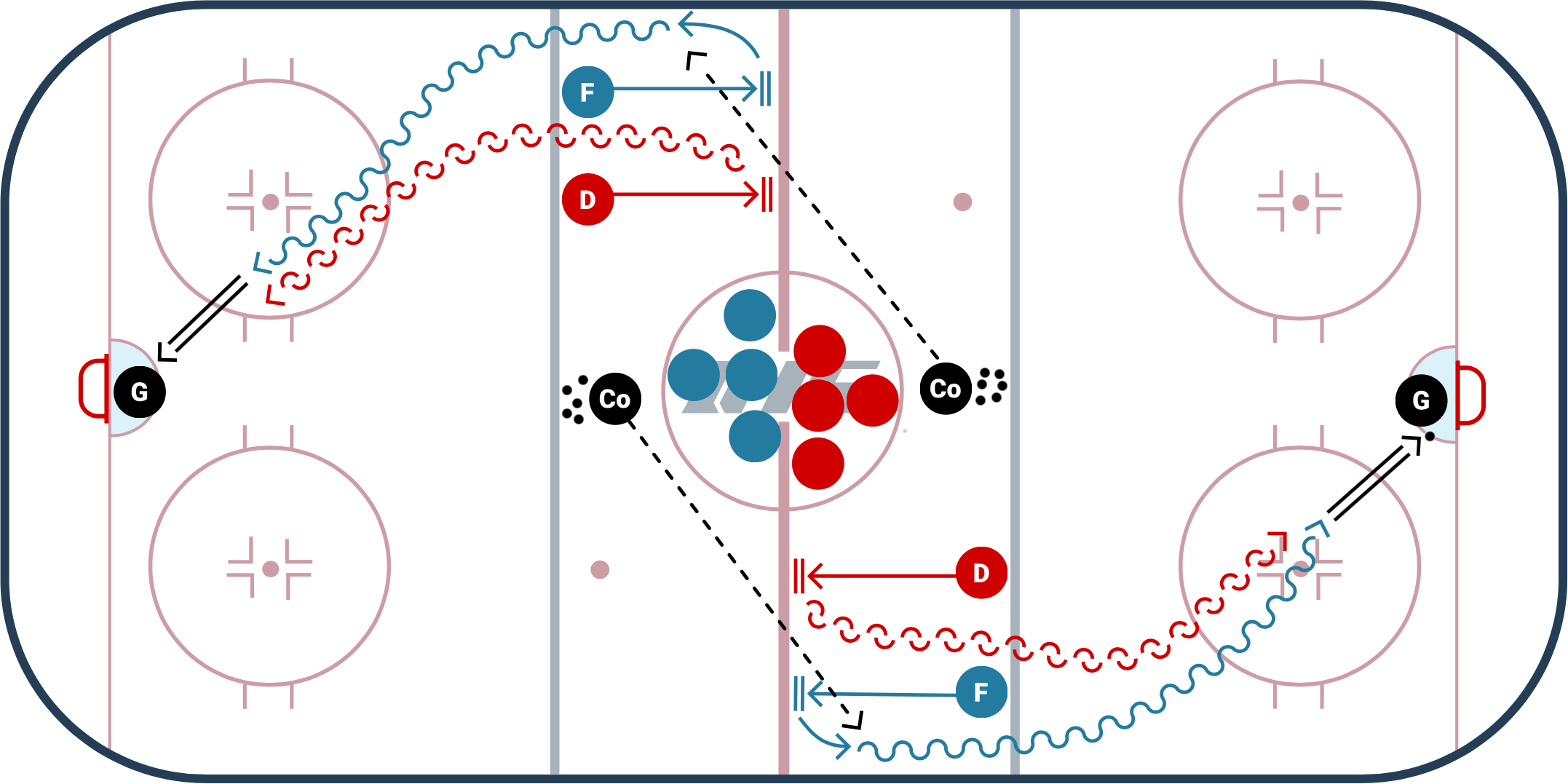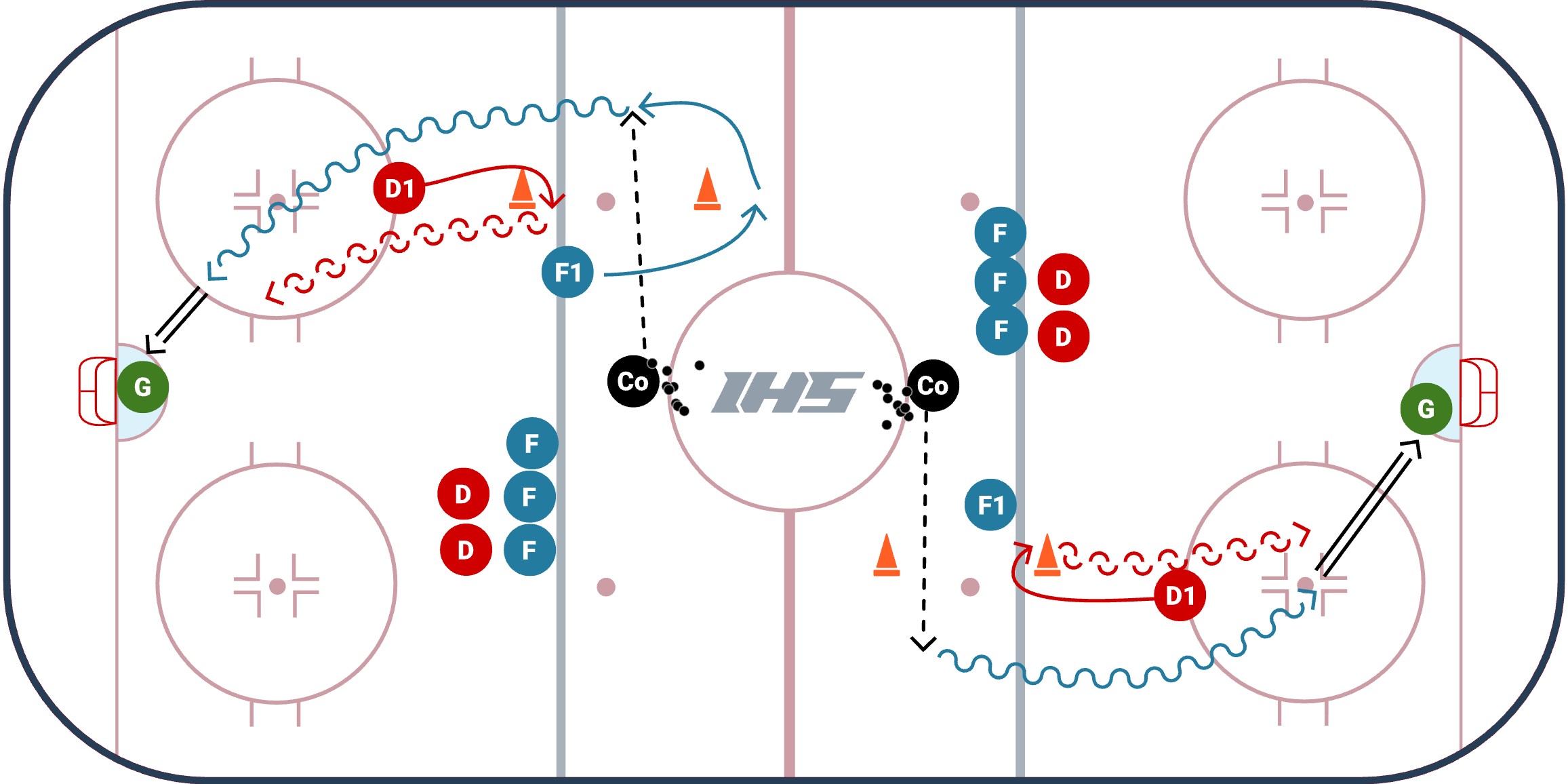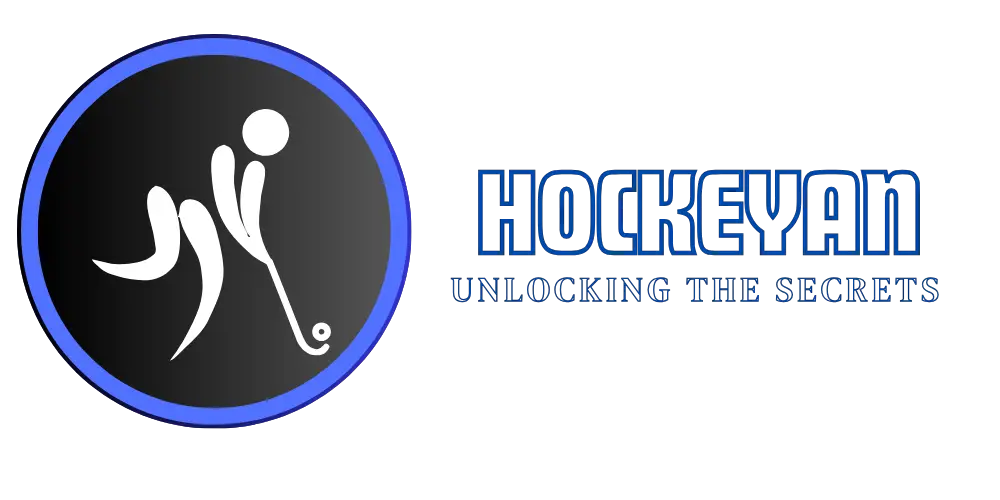Hockey is a thrilling sport. It combines speed, skill, and strategy.
Playing 1 on 1 hockey intensifies this experience. It’s just you against one opponent, no teammates to rely on. This format sharpens your skills and tests your endurance. In the world of hockey, 1 on 1 matches stand out. They are more than just a game.
They are a battle of wits, agility, and precision. You must read your opponent’s moves, react quickly, and make smart decisions. This type of play hones individual talents and boosts confidence. Whether you are a beginner or a pro, 1 on 1 hockey is an excellent way to improve. It’s intense, fast-paced, and a whole lot of fun.

Credit: www.youtube.com
Importance Of 1 On 1 Hockey
1 on 1 hockey is more than just a game; it’s a critical component in developing a player’s skill set. This focused practice offers players the chance to improve their individual abilities, making them more effective on the ice. By facing an opponent one-on-one, players can enhance their techniques, strategic thinking, and overall performance.
Building Confidence
Personal growth in hockey is often tied to confidence. When you engage in 1 on 1 hockey, you face challenges that push you to do better. The small victories in these sessions boost your self-esteem.
For example, successfully outmaneuvering an opponent can give you the confidence to try new moves during a game. The more you practice, the more you trust your skills. How can you expect to play your best if you don’t believe in your abilities?
Remember, confidence is contagious. When you feel it, your teammates can sense it too, making the entire team stronger.
Enhancing Performance
1 on 1 hockey sharpens your skills in a targeted manner. Every move counts, and every mistake is a learning opportunity. This close-quarters practice helps you refine your stick-handling, shooting, and defensive tactics.
I once focused on improving my backhand shot in 1 on 1 sessions. This specific training allowed me to perfect it and use it effectively in actual games. Small changes in your technique can lead to significant improvements.
Are you looking to elevate your game? Consistent 1 on 1 practice could be the key. It’s not just about playing harder; it’s about playing smarter.
Fundamental Skills
Mastering the fundamental skills of 1 on 1 hockey can elevate your game to new heights. These skills are the building blocks of success on the ice. Whether you’re new to the sport or looking to refine your abilities, focusing on skating techniques and stick handling will give you a solid foundation.
Skating Techniques
Strong skating is essential in 1 on 1 hockey. It’s not just about speed, but also agility and control. Practice crossovers to enhance your turns and transitions. This allows you to change directions quickly, keeping your opponent guessing.
Balance is key. Spend time on edge work drills to improve your stability on skates. This helps you maintain control, even under pressure. Remember, a well-balanced player can make precise moves and stay upright during tight maneuvers.
Don’t overlook backward skating. This skill is crucial for effective defense. Practice alternating between forward and backward skating to ensure you can keep up with any opponent. Being proficient in both directions makes you a versatile and unpredictable player.
Stick Handling
Stick handling is more than just moving the puck. It’s about control, precision, and deception. Start with basic drills like figure eights to build your confidence. As you improve, incorporate obstacles to simulate game situations.
Keep the puck close to your body. This makes it harder for opponents to steal and gives you better control. Practice with your head up to improve your awareness on the ice. This habit allows you to see opportunities and threats more clearly.
Use quick, short movements with your wrists. This technique helps you maintain control while making rapid adjustments. Challenge yourself by practicing with different puck handling speeds. Varying your pace can catch your opponent off guard.
What specific skills do you struggle with the most? Identifying your weak points can help you focus your practice effectively. Remember, every great hockey player started with the basics, and mastering these fundamental skills is your first step to becoming a formidable 1 on 1 hockey player.
Offensive Strategies
Offensive strategies are key to winning in 1 on 1 hockey. Players need to create scoring opportunities and use deceptive moves. Mastering these techniques can improve your game significantly.
Creating Scoring Opportunities
Scoring in 1 on 1 hockey requires sharp focus. Always look for openings. Keep the puck close to your stick. This allows quick shots. Move swiftly and change directions. This can confuse your opponent. Use the boards to your advantage. Bounce the puck off to change its path. It can create new angles for scoring.
Deceptive Moves
Deception is crucial in 1 on 1 hockey. Fake shots often. Your opponent will react and create gaps. Use feints with your body. Pretend to go one way, then go the other. Quick shifts in speed also help. Slow down, then burst forward. This can catch your opponent off guard. Practice these moves regularly. They will become second nature in a game.

Credit: www.icehockeysystems.com
Defensive Tactics
Defensive tactics are crucial in 1 on 1 hockey. A strong defense can turn the tide of a game. It’s about more than blocking shots. It involves strategic positioning and reading your opponent’s moves. Let’s dive into some key defensive tactics.
Positioning
Good positioning is the foundation of effective defense. Stay between the puck and your goal. This forces the attacker to work around you. Keep your body low and your stick on the ice. This makes it harder for the opponent to pass or shoot. Maintain a balance between staying close enough to pressure but not too close to get easily bypassed.
Anticipating Opponent Moves
Anticipating your opponent’s moves can give you an edge. Watch their body language and eyes. These can give clues about their next move. React quickly to changes in their direction. Stay aware of their dominant hand and preferred moves. This helps in predicting their actions. Practice reading different styles to improve this skill.
Mental Preparation
Mental preparation is crucial for success in 1 on 1 hockey. You need to be mentally strong to face your opponent. The right mindset can give you an edge. Let’s explore some key aspects of mental preparation.
Focus And Concentration
Focus and concentration are vital in 1 on 1 hockey. You must stay in the moment. Keep your mind clear of distractions. Pay attention to your opponent’s moves. Anticipate their next steps. This will help you react faster and smarter.
Practice mindfulness to improve focus. Take deep breaths before the game. Visualize your success on the rink. This can boost your concentration levels. It helps you stay calm and composed.
Handling Pressure
Handling pressure is another key aspect. 1 on 1 hockey can be intense. The pressure to perform can be overwhelming. But you can manage it. Stay positive and confident.
Break down the game into smaller tasks. Focus on one task at a time. This makes the pressure feel less. Remember, every challenge is an opportunity to grow.
Develop a pre-game routine. It can be as simple as listening to music. Or having a quick chat with a teammate. These small habits can help you stay relaxed under pressure.
Training Drills
When it comes to 1 on 1 hockey, the right training drills can make a huge difference in your performance. Improving both your solo and partner drills will help you become a more versatile and confident player. Below, we delve into some practical and actionable training drills that can significantly enhance your skills on the ice.
Solo Exercises
Solo drills are essential for honing your individual skills. These exercises help you focus on your weaknesses and turn them into strengths. Here are a few solo exercises that can enhance your 1 on 1 hockey game:
- Stickhandling: Practice your stickhandling by navigating through cones or other obstacles. This will improve your control and dexterity with the puck.
- Skating Drills: Work on your speed and agility by doing sprints, crossovers, and tight turns. These will help you outmaneuver your opponent during 1 on 1 situations.
- Shooting Practice: Set up targets in the goal and practice hitting them from different angles and distances. This will enhance your accuracy and confidence in taking shots.
Remember, consistency is key. Make these solo exercises a regular part of your training routine.
Partner Drills
Partner drills are equally important as they simulate real-game scenarios. Training with a partner helps you develop better communication and defensive skills. Here are some partner drills to consider:
- 1 on 1 Battles: Take turns playing offense and defense. This will improve your ability to protect the puck and challenge your opponent effectively.
- Passing Drills: Practice passing the puck back and forth while moving. This improves your timing and accuracy, which are critical in a game.
- Shadowing: One player tries to shadow the other, mimicking their movements. This drill enhances your defensive positioning and anticipation.
Working with a partner not only makes training more fun but also pushes you to perform better. It’s a great way to learn from each other and build team chemistry.
So, which training drill will you try first? Share your thoughts and experiences in the comments below. Your insights could help fellow players improve their game!
Equipment Essentials
In 1 on 1 hockey, having the right equipment is crucial. Good gear enhances performance and ensures safety. Let’s explore the essentials you need.
Choosing The Right Gear
Selecting proper equipment starts with a well-fitted helmet. It protects the head from impacts. The helmet should be snug, not tight. Next, focus on skates. They must provide comfort and support. Ill-fitting skates lead to injuries. Gloves are vital too. They protect hands and improve grip on the stick. Opt for gloves with good padding.
Shin guards and elbow pads are necessary. They shield you from pucks and falls. Make sure they fit well. A hockey stick must match your height and playing style. Too long or too short can affect control. Finally, a mouthguard is essential. It prevents dental injuries.
Maintaining Equipment
Proper maintenance extends the life of your gear. Always dry your equipment after use. Wet gear promotes bacteria growth. Clean your helmet and pads regularly. Use mild soap and water. Check your skates’ blades. Sharpen them as needed. Dull blades hinder performance.
Inspect your stick for cracks or splinters. Replace it if necessary. Store your gear in a cool, dry place. Avoid direct sunlight. It can damage the materials. Regularly check for wear and tear. Address issues promptly. Well-maintained gear keeps you safe and ready to play.

Credit: www.icehockeysystems.com
Analyzing Professional Players
Studying professional hockey players can improve your 1 on 1 hockey skills. Watching the best players helps you learn new techniques. You can see how they move, think, and react. It is a great way to improve your own game.
Learning From The Best
Watch professional games to see top players in action. Pay attention to their positioning on the ice. Notice how they handle the puck. Observe their defensive and offensive strategies. This will give you insights into their decision-making processes.
Focus on players who excel in 1 on 1 situations. Study their moves and techniques. Notice how they create space and opportunities. Take note of their speed and agility.
Applying Techniques To Your Game
Once you observe these techniques, practice them. Start with basic drills. Work on your skating, puck handling, and shooting. Try to mimic the moves you saw in the games.
Practice consistently. The more you practice, the better you will get. Incorporate these techniques into your regular game play. This will help you become a more effective player in 1 on 1 situations.
Frequently Asked Questions
What Is A 1v1 In Hockey?
A 1v1 in hockey is a one-on-one situation. It involves one attacker facing one defender or a goalie.
How Do You Play 1 On 1 Hockey?
To play 1 on 1 hockey, each player tries to score against the other. Use your stick to control the puck, and aim to get it past your opponent into their goal. The player with the most goals at the end wins.
What Is 1 Vs 1 Hockey Game?
A 1 vs 1 hockey game is a match where two players compete directly against each other on the ice.
What Is The Hardest Hockey Drill?
The hardest hockey drill is the “Herbies” or “Suicides. ” It involves intense skating, stopping, and turning at high speeds.
Conclusion
1 on 1 hockey offers thrilling, fast-paced action. It’s a great way to improve skills. Players can focus on strategy and technique. The game helps build stamina and agility. Perfect for those who love challenges. It brings excitement to practice sessions.
Great for all ages and skill levels. Enjoy the intensity and fun of 1 on 1 hockey. Keep playing, keep improving. Hockey enthusiasts will love the experience. It’s an excellent way to get better at the sport. Dive into the world of 1 on 1 hockey today.




